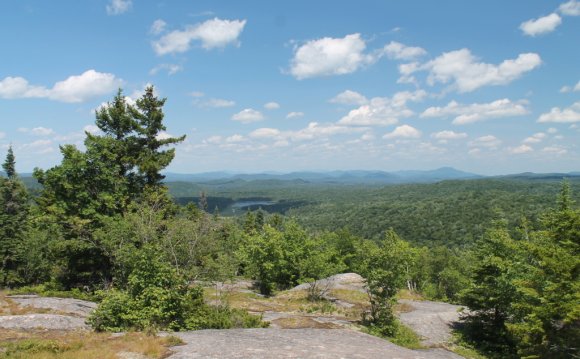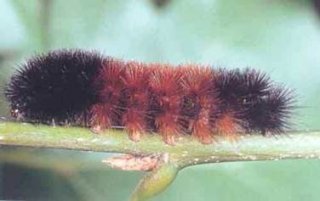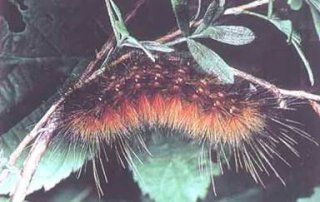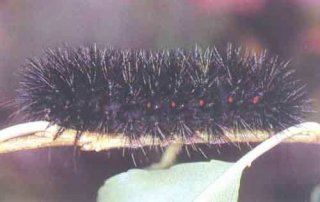

Woolly Bear Caterpillar: A Winter Weather Predictor or Not?
| Most people in the Midwest or New England have heard at one time or another that if you want a forecast for the upcoming winter that you should just look for a woolly bear (black at both ends and a reddish brown or rust colored in the middle) or fuzzy bear caterpillar. This same caterpillar is called the woolly worm in southern United States. Yet another name for this caterpillar is the Hedgehog Caterpillar, because it curls into a tight bristly ball and “plays dead” when picked up or disturbed. Whatever name they go by, they are often found in the autumn after they have left their food plants (variety of grasses and weeds including plantain, dandelion, and nettles) in search of a dark and sheltered spot where they can hibernate as larvae for the winter. |
The (Pyrrharctia isabella) Caterpillar is found across the United States, Canada, and Mexico. |
Woolly Bear Folklore:
According to folklore, the amount of black on the woolly bear in autumn varies proportionately with the severity of the coming winter in the locality where the caterpillar is found. The longer the woolly bear's black bands, the longer, colder, snowier, and more severe the winter will be. Similarly, the wider the middle brown band is associated with a milder upcoming winter. The position of the longest dark bands supposedly indicates which part of winter will be coldest or hardest. If the head end of the caterpillar is dark, the beginning of winter will be severe. If the tail end is dark, the end of winter will be cold. In addition, the woolly bear caterpillar has 13 segments to its body, which traditional forecasters say correspond to the 13 weeks of winter.
 As with most folklore, there are 2 other versions to this story. The first one says that the woolly bear caterpillar's coat will indicate the upcoming winter's severity. So, if its coat is very woolly, it will be a cold winter. The final version deals with the woolly bear caterpillar's direction of travel of the worms. It is said that woolly bear's crawling in a southerly direction are trying to escape the cold winter conditions of the north. On the other hand, woolly bear's crawling on a northward path would indicate a mild winter.
As with most folklore, there are 2 other versions to this story. The first one says that the woolly bear caterpillar's coat will indicate the upcoming winter's severity. So, if its coat is very woolly, it will be a cold winter. The final version deals with the woolly bear caterpillar's direction of travel of the worms. It is said that woolly bear's crawling in a southerly direction are trying to escape the cold winter conditions of the north. On the other hand, woolly bear's crawling on a northward path would indicate a mild winter.
The popularity of the woolly bear caterpillar has resulted in several festivals honoring them. Since 1973, the residents of Vermilion, Ohio have held an annual "Woolly Bear Festival". The festival is the brainchild of legendary Cleveland TV personality Dick Goddard, longtime weatherman at WJW-TV. It is claimed to be the largest one-day festival in Ohio. Festivities include a parade, woolly bear races and an "official" analysis of the woolly bears and forecast for the coming winter. Also, every 3rd weekend in October the annual is held in Banner Elk, NC. They begin worm their worm races around 10:20 AM, or as soon as the first heat, on Saturday morning. Races continue all day until the grand final about 4 PM when the champion worm and trainer is crowned (and paid!). At that time, the official winter forecast will be declared. Sunday worm races are for fun and small prizes and will continue throughout the day as long as there are race participants. Other festivals are held in Beattyville, KY (began in 1987); Lewisburg, PA (began in 1997); Oil City; PA (began in 2008); and Lion's Head, Ontario (began in 2011).
 Folklore Demythed:
Folklore Demythed:
Even though it is widely believed that the woolly bear caterpillar can predict the upcoming winter's severity, the truth is that this caterpillar can't predict what Old Man Winter has in store for us in the upcoming winter. The woolly bear caterpillar's coloring is based on how long caterpillar has been feeding, its age, and species. The better the growing season is the bigger it will grow. This results in narrower red-orange bands in its middle. Thus, the width of the banding is an indicator of the current or past season's growth rather than an indicator of the severity of the upcoming winter. Also, the coloring indicates the age of the woolly bear caterpillar. The caterpillars shed their skins or molt six times before reaching adult size. With each successive molt, their colors change, becoming less black and more reddish. In addition, there are approximately 260 species of tiger moths (the adult of the woolly bear caterpillar) in North America, and each species has slightly different color patterns and hair coverings. As a result, some of the color and hair variations that we see each fall are a result of these different species.
|
According to folklore, someone would assume a mild upcoming winter from seeing the caterpillar above, but in actuality this is a (Spilosama virginica). This caterpillar always looks like this regardless of what happens during the upcoming winter. It is found across the United States, Canada, and Eastern Mexico. |
According to folklore, someone would assume a severe upcoming winter from seeing the caterpillar above, but in actuality this is a (Ecpantheria scribonia). This caterpillar always looks like this regardless of what happens during the upcoming winter. It is found across the eastern half of the United States and Canada. |
As far as the story about the woolly caterpillar's coat, this is how Mother Nature helps it survive winter. The fur is called setae and it isn't there to protect them from the cold weather. Instead it actually helps them to freeze more controllably. Here is something truly remarkable. Once settled in, the caterpillars hibernate, creating a natural organic antifreeze called glycerol. They freeze bit by bit, until everything but the interior of their cells are frozen. These interior cells are protected by the hemolymph. Woollybears can - and do - survive to temperatures as low as -90oF. This ability to adapt to cold shows up particularly in the Arctic, where the woolly worms live in a strange state of slow motion. Most caterpillars live for two to four weeks before becoming moths. The Arctic woolly worms, however, spend at least 14 years in the process! The woolly bear caterpillar has even been known to survive an entire winter completely frozen in an ice cube.
As far as the woolly bear caterpillar's travel goes, they are simply moving about in search for that perfect spot to curl up and spend the winter. This is usually under bark, a rock, or a fallen log.
|
Even though there is great interest in its caterpillar stage, very few people know what it grows up to be. Each fuzzy, 1½ inch caterpillar becomes an . After wintering in its chosen spot, the caterpillar awakens on a warm spring day and continues to feed. Soon it forms a cocoon and pupates. In about two weeks, an orange-yellow moth with 1 ½ to 2-inch wingspan emerges. The wings lack distinctive markings but the abdomen is spotted with three longitudinal rows of small black dots. These moths are active at night throughout summer. |
RELATED VIDEO












